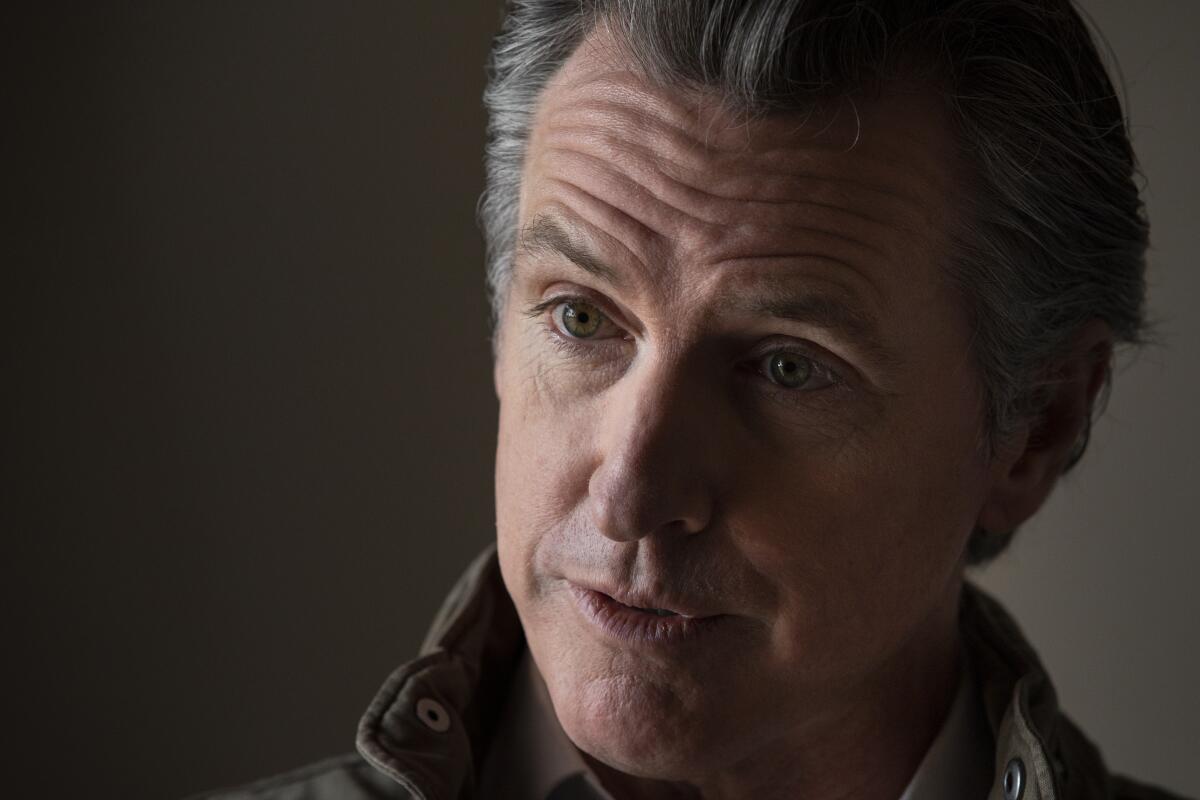Inside Newsom’s trip to the Mexico border

- Share via
IMPERIAL COUNTY — With Republicans set to take control of the U.S. House of Representatives and promising to put border enforcement front-and-center next year, Gov. Gavin Newsom traveled to the U.S.-Mexico border this week to hammer the GOP for politicizing the issue and failing to consider legitimate, bipartisan reforms to fix America’s broken immigration system.
I’m Taryn Luna and I cover Newsom for the Los Angeles Times. I met with the Democratic governor at the Imperial County immigration center to hear his concerns, not only about Republicans in Washington but also about California’s ability to continue its outsized role in helping immigrants.
First, a little bit of news. Newsom plans to frame his Jan. 6 second-term inauguration as the antithesis to the “far-right’s insurrection and failed attempt to topple American democracy” two years ago when supporters of then-President Trump stormed the Capitol in Washington. In a fundraising email, the governor said he plans to lead a march of Californians from “every corner of the state” to the state Capitol.
Newsom’s plans are sure to, once again, stir speculation about his future political aspirations, just as wading into federal border policy did earlier this week.
Please leave the room
My journey to interview Newsom included an early-morning, two-and-a-half hour drive from San Diego International Airport through a mountain snowstorm to Imperial County, where I met him at a state-funded immigration center near the border.
The oft-late governor was running nearly two hours ahead of schedule and I arrived to find him speaking with staff from his administration’s Office of Emergency Services and the immigration facility.
I leaned in to listen. He paused, tried to soften what he would say next with a rare compliment, and then asked me to leave the room.
I awkwardly obliged.
Newsom later explained, as we talked in one of many rooms that house asylum seekers after they are released from federal detention, that he wanted to ask detailed questions out of my earshot about how California could withdraw from its humanitarian operation on the border. Newsom said the state has spent nearly $1 billion working with nonprofits to provide support to immigrants released from federal detention — mostly to fill the void that was left by the Trump administration — and California can’t continue that level of funding given its budget deficit.
“What do we do, like how do we do this? How do we process that and how do you scale it back?” Newsom said.
“And lessen the impact?” I asked.
“Yeah, that’s what we’ve got to figure out,” he said.
‘This is a federal government issue’
Newsom originally wanted to travel to the border that day without any reporters, which perhaps contrary to his media-hungry image seems to be his general preference when he leaves the governor’s office in Sacramento and travels through the state.
A few minutes into his tour of the facility, I learned why I and Matt Gutman, an ABC News national correspondent, were allowed to tag along, despite the administration’s concerns about security at the center.
We walked into a large room that immigrants file into every day after they arrive at the facility on buses from ports of entry along the border. Staff said the state and its nonprofit partners work with about 1,000 arrivals each day across nine facilities in Imperial, Riverside and San Diego counties. That number could grow exponentially, they said, when the federal Title 42 policy lifts, which is supposed to happen by Dec. 21.
In November, a federal judge struck down Title 42, a public health law used by the Trump administration during the COVID-19 pandemic to allow border agents to expel migrants. President Biden announced plans to lift the public health order in April and faced legal challenges from Republican states.
Seated in chairs dispersed throughout the room, they received basic health screenings for signs of COVID-19 and flu, and were assessed for other needs. They remain at the facility for an average of about two days, though some stay longer if they have COVID. Many arrive with their own money to reach their destination, which is commonly Florida or Oregon, workers said. Nonprofits support those who don’t have their own means and help them connect with family and friends elsewhere.
Newsom stepped toward me.
“My frustration is, it’s us,” he said, gesturing to the room. “This is a federal government issue.”
He said the same to Gutman, but added an expletive.
Newsom calls out GOP
Newsom’s objective for the day was clear: To get a firsthand look at the operation and make his threat to cut back state funding heard from here to Washington.
He aimed his grievances at Republicans in Congress with jabs that earned national attention and retorts from Fox News hosts that evening. Sean Hannity derided Newsom’s trip, calling the governor “Mr. Sanctuary State,” a reference to a 2017 law signed by Gov. Jerry Brown that prevents law enforcement officers in many cases from holding and questioning people at the request of federal immigration agents, and limits them from sharing the release dates of some county jail inmates who are in the country illegally.
Newsom called the conservative talk show hosts “a—holes” and said both the outlets and the GOP exploit the issue of immigration as only about border security.
He took at shot at House Minority Leader Kevin McCarthy (R-Bakersfield), saying he expected “nothing constructive” if he becomes speaker.
“Yes, we need border security,” Newsom said. “But it’s not just about that. It’s about a broken immigration system, an asylum system that has to be reformed.”
He was careful not to blame Biden, saying Congress needed to appropriate funds to support the services the Trump administration walked away from and California picked up.
The day also served as a preview of what to expect from Newsom in January when he reveals his larger state budget proposal as California faces a deficit.
Newsom said he would stay true to his word to fund priorities from prior budgets that take effect in the years ahead, but some details may be altered considering the revenue shortfall.
“The challenge is the timelines may change, and that’s an issue and that’s just level setting with folks, but historic investments and historic expansion, we’re going to continue down that path,” Newsom said. “It’s just a question of dates and timelines and the resources we’ll have in the short run versus the medium and long run.”
Enjoying this newsletter? Consider subscribing to the Los Angeles Times
Your support helps us deliver the news that matters most. Become a subscriber.
California politics lightning round
— In a tribute to former Sen. Bob Hertzberg, columnist George Skelton argues that California would be better off without legislative term limits.
— A court’s decision to block the massive Capitol renovation project should remind California politicians that the building does not belong to them, Skelton writes.
— When President Biden signed a federal gay-marriage law this week, it was a powerful validation of early political risk-taking by Gov. Gavin Newsom and Vice President Kamala Harris, who were at the vanguard of what became an overwhelming shift in how Americans think about civil rights, family and love.
— Can California’s electric-vehicle push overcome the red-state backlash? A national climate that includes Republican lawsuits against California vehicle emissions rules and televised warnings that they represent an attack on freedom suggests that the country remains divided over embracing a technology that environmentalists say is essential to combating climate change.
— Columnist Jean Guerrero reports on Imperial County, the state’s most heavily Latino county — and also one where Republicans are making gains.
— The twisted tale of an L.A. con man included attempts to cozy up to California political leaders with generous campaign contributions, including Newsom. A spokesman for the governor’s political committee says Newsom has donated the full amount of those contributions to two public-interest law firms.
— The Times editorial board argues that the Legislature should compel school districts to share their salary data with the state controller.
— The Supreme Court rejected a last-minute plea from the tobacco industry and cleared the way for California to enforce a statewide ban on the sale of most flavored tobacco products, including menthol cigarettes.
Stay in touch
Did someone forward you this? Sign up here to get California Politics in your inbox.
Until next time, send your comments, suggestions and news tips to capolitics@latimes.com.
Sign up for Essential California
The most important California stories and recommendations in your inbox every morning.
You may occasionally receive promotional content from the Los Angeles Times.




